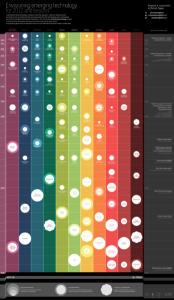Faculty Peer ReviewedÂ
Although millions of dollars are spent towards cancer research every year, progress toward a cure is less than ideal. Last year the New York Times posted a piece about the burgeoning improvements on the genomic front that could lead to a new approach to cancer treatment. “The promise is that low-cost gene sequencing will lead to a new era of personalized medicine, yielding new approaches for treating cancers and other serious diseases†[1]. Through genomic technology, physicians will be able to tailor chemotherapeutic regimens and treatments to each patient’s specific cancer. While this sounds like the holy grail of cancer treatment, it’s not as easy as it seems.
The notion of personalized medicine sprang from the human genome project, which sequenced the 30,000-40,000 protein-coding regions that make up human DNA [2]. Each type of cancer has a unique genome with redundant mutations and coding regions that can be manipulated as possible drug targets.
An excellent example of the application of genomics in cancer medicine is breast cancer. Gene-expression profiles have been generated that have identified different biomarkers for each subtype of breast cancer (estrogen receptor/progesterone receptor/ HER2/neu receptor). These biomarkers have shaped the way we currently treat breast cancer. Every subtype of breast cancer produces unique proteins and relies upon discrete growth factors. It is through these protein differences that targeted therapy is made possible [3]. For example, the discovery of the HER2 receptor and its associated monoclonal antibody, trastuzumab, changed the battlefield of breast cancer. Before the advent of trastuzumab, HER2 as a biomarker was a poor prognostic marker for survival, with an increased rate of relapse after surgery. With the addition of trastuzumab to standard chemotherapy, women with metastatic HER2-positive breast cancer who had not received prior chemotherapy had an increase in survival from 4.6 months to 7.4 months [4]. More recently, the application of HER2-targeted adjuvant therapy in early stage disease has changed the prognosis of HER2-positive breast cancer forever, preventing recurrences and significantly prolonging survival in patients whose cancer does relapse.
The cancer genome project along with other research endeavors began sequencing multiple tumors from each type of cancer. Through sequencing, researchers can look at which mutations “drive†the cancer to grow, invade, and metastasize. By targeting these driver mutations, therapies will be able to cut to the core of the cancer, destroying the tumor’s foundation [5]. With genotyping becoming more affordable, we will be able to sequence each patient’s tumor to determine which oncogene or tumor suppressor is fueling his or her specific cancer. In a perfect world, this may be the answer, but the molecular biology of cancer is not so straightforward. A 2012 article in the New England Journal of Medicine describes the heterogeneous landscape of the molecular biology of a cancer cell. Intratumor heterogeneity is a big problem, with each tumor undergoing its own evolutionary process within the patient. Every tumor is made up of millions of different cells that are accumulating mutations at various loci and at different rates. By sequencing just one part of the tumor, physicians may miss the essential part of the tumor that is driving growth or allowing for metastases. Through phylogenetic reconstruction of the numerous parts of a patient’s tumor, there is marked branched evolutionary tumor growth. This tumor heterogeneity may halt the prospects of personalized medicine by opening a Pandora’s box of mutations [6]. Through disparate mutations the tumor may harbor many different varieties of biomarkers, thus making it more challenging to find a single perfect drug target for each cancer.
Chemotherapy is a mainstay for shrinking a tumor before surgery or killing residual cancer cells that continue to grow and divide after surgery. Although the side effects of chemotherapy have been reduced by newer and better anti-nausea regimens and the use of growth factors to prevent low blood counts and infections, chemotherapy treatment remains difficult and unpleasant for most. The hope is that chemotherapy will be replaced by more specific targeted therapies with fewer side effects. However, more basic research and clinical trials will be needed to define appropriate targets and to combine therapies so that we may address the important issue of tumor heterogeneity. Personalized medicine is still the goal, but until more work is done at the bench and at the bedside, it may fall short of its promise.
Jessica Billig is a 4th year medical student at NYU School of Medicine
Peer reviewed by Ruth Oratz, MD, Department of Medicine, NYU Langone Medical Center
Image courtesy of Wikimedia Commons
References
1. Markoff J. Cost of gene sequencing falls, raising hopes for medical advances. New York Times. Mar 10, 2012. http://www.nytimes.com/2012/03/08/technology/cost-of-gene-sequencing-falls-raising-hopes-for-medical-advances.html.Accessed March 21, 2012.
2. Lander ES, Linton LM, Birren B, et al. Initial sequencing and analysis of the human genome. Nature. 2001;409(6822):860-921.
3. Sotiriou C, Pusztai L. Gene-expression signatures in breast cancer. N Engl J Med. 2009;360(8):790-800. http://www.ncbi.nlm.nih.gov/pubmed/19228622
4. Hudis CA. Trastuzumab—mechanism of action and use in clinical practice. N Engl J Med. 2007;357(1):39-51.
5. Stratton MR, Campbell PJ, Futreal PA. The cancer genome. Nature 2009; 458(7239):719-724. http://www.ncbi.nlm.nih.gov/pubmed/19360079
6. Gerlinger M, Rowan AH, Horswell S, et al. Intratumor heterogeneity and branched evolution revealed by multiregion sequencing. N Engl J Med 2012; 366(10):883-892.

